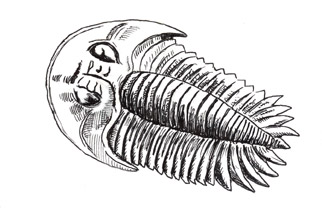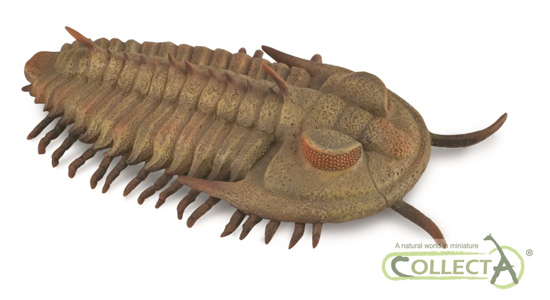Complex Behaviour in Cambrian Arthropods
Fossil Evidence of Complex Arthropod Behaviour
A new scientific study examines complex behaviour in Cambrian arthropods. Arthropods are the largest phylum of animals, with a great number of diverse forms and numerous modes of life. The first arthropods appear in the fossil record around 545 million years ago around the time of a great increase in life on Earth, known as the Cambrian explosion.
Trilobites were among the first arthropods to evolve, and account for approximately one third of all fossils found in Cambrian rocks. Evolving a hard, outer coat (exoskeleton) which is segmented and paired, jointed legs and other appendages, plus the ability to grow via moulting – characteristics of all arthropods has proved to be a very successful evolutionary strategy. Arthropods are found in virtually possible habitat on land and water and members of this phylum include crustaceans, millipedes, centipedes, spiders, mites, scorpions and of course the most abundant of all – insects.
Cambrian Arthropods
The trilobite, from humble origins evolved into something like 9 or 10 different Orders. The Trilobita diversified into a multitude of different forms, although entirely marine, these animals survived right up to the end of the Palaeozoic (end of the Permian) and represent one of the most important faunas in the entire fossil record.
An Illustration of a Typical Trilobite

Picture credit: Everything Dinosaur
Trilobites get their name (it means three-lobed) as their bodies can be divided into three distinct sections both longitudinally and cross-ways. There is a central axis running down the body, with a left lobe and right lobe. In cross section, trilobites have a headshield (cephalon), a trunk (thorax) and a tail section (pygidium).
To view fossil replicas including trilobite models: CollectA Prehistoric Life Models and Figures.
It is easy for members of the public to dismiss such animals from Earth’s pre-history as ancient, simple animals, but an amazing fossil from China has provided scientists with an insight into early arthropod behaviour and revealed that these ancient relatives of modern arthropods were capable of the same sort of complex behaviours seen in many extant arthropods today.
Cambrian Fossils
A set of fossils dating from the Cambrian (525 million years ago approximately), indicate that some forms of early marine crustacean gathered together in large groups and were capable of collective behaviour, according to an international team of scientists.
Fossil evidence of collective behaviour is extremely rare. But what makes the find even more intriguing is that it indicates that such behaviour was occurring at the beginning of the Phanerozoic, an eon of time that began around 550 million years ago and marks the stage in the fossil record when hard shells and other structures appear.
The fossils, found in Yunnan province in south west China, were analysed by a team of scientists from Oxford University, the University of Leicester and Yunnan University, China. The find is reported in an article in the journal Science. During the Cambrian, the country we know as China today, consisted of two separate and submerged continental masses that lay in a warm, tropical sea of the coast of a large landmass called Gondwana. This shallow sea teamed with life and some elements have been preserved as fossils to create an extensive record of early marine life in this part of the world.
Burgess Shale Deposits
This area rivals the Burgess Shale deposits in British Columbia, Canada, in terms of the exceptionally well-preserved Cambrian fossils that have been found, although the strata is slightly younger than the famous Cambrian fossil bearing strata of the Burgess Shale.
However, the Burgess Shale deposits have been studied for nearly 100 years, whilst these Chinese deposits, first examined in 1984 have yet to be fully explored.
Pictures of the the fossil show a group of shrimp-like animals which have formed a linked line and seem to be travelling together across the sea bed. The close up shows two animals in more detail.
Commenting on this discovery, Professor Derek Siveter of the Oxford University Museum of Natural History and co-author of this study stated:
“What’s unique about the Yunnan fossil material is that it shows individual specimens closely interlocked to form a chain, of which there are several examples.”
These chains may have formed for reproductive purposes, or they may represent a stage in the animal’s life cycle – if so, there are no comparable occurrences in modern arthropods. However, similar behaviour is seen in some species of crustacea today, such as lobsters. These animals form chains and move collectively, migrating across the seabed heading for breeding grounds. Such chains are formed to protect individual animals from predators, whilst they move out in the open. A large co-ordinated chain may confuse potential attackers and deter them from making an attack.
Migratory Activity
The scientists have speculated that this congregation is likely to be evidence of migratory activity, possibly associated with animals congregating as a defence against predators. Although, it is difficult to draw conclusions about the behaviour of organisms from fossil evidence.
A Model of a Trilobite
Professor Siveter added:
“The simplest explanation is that what we are seeing is reflecting some sort of migration. The spiny lobster is one example of this sort of migratory behaviour seen amongst modern arthropods. These lobsters join together in a kind of ‘train’ with the antennae of one animal sometimes touching the tail of the animal in front. However, the animals represented by the Chinese fossils are much more closely interlocked – they formed ‘chains’ rather than ‘trains’’’.
“This amazingly rich period in the history of life saw the appearance of more or less all the major groups of animals that provide the biodiversity we see around us today.” continued Professor Siveter.
“This find demonstrates that the creatures in our seas 525 million years ago were far from primitive, in fact they were complex organisms exhibiting some very sophisticated behaviour”.
The Yunnan Province will probably yield more amazing discoveries in years to come, providing scientists with a unique insight into an ancient world that existed over 500 million years ago.


